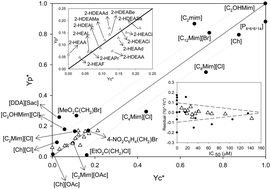Cytotoxic effect of protic ionic liquids in HepG2 and HaCat human cells: in vitro and in silico studies†
Abstract
Protic ionic liquids (PILs) are innovative chemical compounds, which due to their peculiar nature and amazing physico-chemical properties, have been studied as potential sustainable solvents in many areas of modern science, such as in the industrial fields of textile dyeing, pharmaceuticals, biotechnology, energy and many others. Due to their more than probable large-scale use in a short space of time, a wider analysis in terms of ecotoxicity and biological safety to humans has been attracting significant attention, once many ionic liquids were found to be “a little less than green compounds” towards cells and living organisms. The aim of this study is to investigate the cytotoxicity of 13 recently synthesized PILs, as well as to reinforce knowledge in terms of key thermodynamic magnitudes. All the studied compounds were tested for their in vitro toxic activities on two human cell lines (normal keratinocytes HaCaT and hepatocytes HepG2). In addition, due to the enormous number of possible combinations of anions and cations that can form ionic liquids, a group contribution QSAR model has been tested in order to predict their cytotoxicity. The estimated and experimental values were adequately correlated (correlation coefficient R2 = 0.9260). The experimental obtained results showed their remarkable low toxicity for the studied in vitro systems.



 Please wait while we load your content...
Please wait while we load your content...